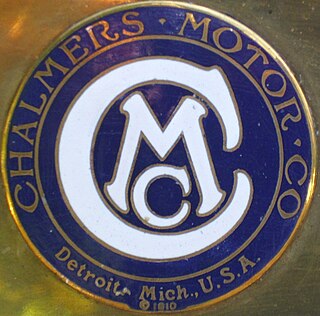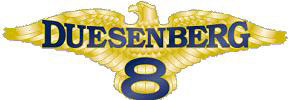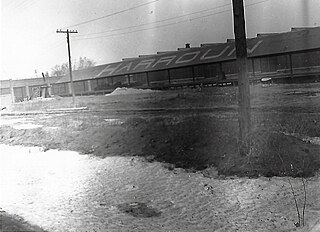Related Research Articles

Hupmobile was an automobile built from 1909 through 1939 by the Hupp Motor Car Company of Detroit. The prototype was developed in 1908 and had its first successful run on November 8 with investors aboard for champagne at the Tuller Hotel a few blocks away. The company was incorporated in November of that year. The first Hupmobile model, the Hupp 20, was introduced at the 1909 Detroit automobile show. It was an instant success.

Studebaker was an American wagon and automobile manufacturer based in South Bend, Indiana. Founded in 1852 and incorporated in 1868 as the Studebaker Brothers Manufacturing Company, the firm was originally a producer of wagons, buggies, carriages and harnesses. Studebaker continued to manufacture other diversified products after automobile production ceased in 1966.

Chalmers Motor Company was an American automobile company headquartered in Detroit, Michigan. It started in 1908 and continued production of high end vehicles until 1923 when it merged with Chrysler.

The Brass Era is an American term for the early period of automotive manufacturing, named for the prominent brass fittings used during this time for such things as lights and radiators. It is generally considered to encompass 1896 through 1915, a time when these vehicles were often referred to as horseless carriages.

Stoddard-Dayton was a high quality car manufactured by Dayton Motor Car Company in Dayton, Ohio, USA, between 1905 and 1913. John W. Stoddard and his son Charles G. Stoddard were the principals in the company.

Duesenberg Motors Company was an American manufacturer of racing cars and high-end luxury automobiles. It was founded by brothers August and Frederick Duesenberg in 1913 in Saint Paul, Minnesota, where they built engines and racing cars. The brothers moved their operations to Elizabeth, New Jersey, in 1916 to manufacture engines for World War I. In 1919, when their government contracts were cancelled, they moved to Indianapolis, Indiana, home of the Indianapolis Motor Speedway, and established the Duesenberg Automobile and Motors Company, Inc. (Delaware). In late 1926, E.L. Cord added Duesenberg to his Auburn Automobile Company. With the market for expensive luxury cars severely undercut by the Great Depression, Duesenberg folded in 1937.

MTU Friedrichshafen GmbH is a manufacturer of commercial internal combustion engines founded by Wilhelm Maybach and his son Karl Maybach in 1909. Wilhelm Maybach was the technical director of Daimler-Motoren-Gesellschaft (DMG), a predecessor company of the German multinational automotive corporation Daimler AG, until he left in 1907. On 23 March 1909, he founded the new company, Luftfahrzeug-Motorenbau GmbH, with his son Karl Maybach as director. A few years later the company was renamed to Maybach-Motorenbau GmbH, which originally developed and manufactured diesel and petrol engines for Zeppelins, and then railcars. The Maybach Mb.IVa was used in aircraft and airships of World War I.

The Mercedes-Benz W114 and W115 were the internal designation Mercedes-Benz used for a generation of front-engine, rear-drive, five-passenger sedans and coupés introduced in 1968, with three-box styling by Paul Bracq — succeeding the W110 Fintail models introduced in 1961; and manufactured until model year 1976, when the W123 was released.

Daimler-Motoren-Gesellschaft (DMG) was a German engineering company and later automobile manufacturer, in operation from 1890 until 1926. Founded by Gottlieb Daimler and Wilhelm Maybach, it was based first in Cannstatt. Daimler died in 1900, and their business moved in 1903 to Stuttgart-Untertürkheim after the original factory was destroyed by fire, and again to Berlin in 1922. Other factories were located in Marienfelde and Sindelfingen.

The Premier Motor Manufacturing Company was organized in 1903 by George A. Weidely and Harold O. Smith in Indianapolis, Indiana. The company built automobiles with air-cooled engines.

Russo-Balt was one of the first Russian companies that produced vehicles and aircraft between 1909 and 1923.

Beijing Benz is an automotive manufacturing company headquartered in Beijing, China, and a joint venture between BAIC Motor and Daimler AG.

The Owen Magnetic was a pioneering American brand of hybrid electric luxury automobiles manufactured between 1915 and 1922. Car models of the brand were notable for their use of an electromagnetic transmission and were early examples of an electric series hybrid drivetrain. The manufacture of the car was sponsored by R.M. Owen & Company of New York, New York. The car was built in New York City in 1915, in Cleveland, Ohio, between 1916 and 1919 and finally in Wilkes-Barre, Pennsylvania, in 1920 and 1921.

Frederick Samuel Duesenberg was a German-born American automobile and engine designer, manufacturer and sportsman who was internationally known as a designer of racecars and racing engines. Duesenberg's engineering expertise influenced the development of the automobile, especially during the 1910s and 1920s. He is credited with introducing an eight-cylinder engine, also known as the Duesenberg Straight-8 engine, and four-wheel hydraulic brakes, a first for American cars, in addition to other mechanical innovations. Duesenberg was also patentholder of his designs for a four-wheel hydraulic brake, an early automatic transmission, and a cooling system, among others. Fred and his younger brother, August "Augie" Duesenberg, shared the patents, filed in 1913 and renewed in 1918, for their "walking beam" four-cylinder engine and the Duesenberg Straight 8.

Barley Motor Car Co. was a manufacturer of automobiles in Kalamazoo, Michigan, and Streator, Illinois. It manufactured the Roamer automobile (1916–29) and, briefly, the Barley (1922–24), and the Pennant (1924–25).

The Harroun was an automobile manufactured in Wayne, Michigan by the Harroun Motor Sales Corporation from 1916 to 1920. The company bore the name of its founder, racing legend Ray Harroun, who in 1911 won the first Indianapolis 500 Sweepstakes.
The Yale was a Brass Era car manufactured in Saginaw, Michigan from 1916 to 1918, not to be confused with the Yale from Toledo, Ohio.
Mercedes-Benz is a German global automotive marque and a subsidiary of Daimler AG. Mercedes-Benz is known for producing luxury vehicles and commercial vehicles. The headquarters is in Stuttgart, Baden-Württemberg. The name first appeared in 1926 under Daimler-Benz. In 2018, Mercedes-Benz was the largest seller of premium vehicles in the world, having sold 2.31 million passenger cars.
References
- ↑ Kimes, Beverly Rae (1996). Standard Catalog of American Cars 1805-1942. Krause Publications. ISBN 0-87341-428-4.